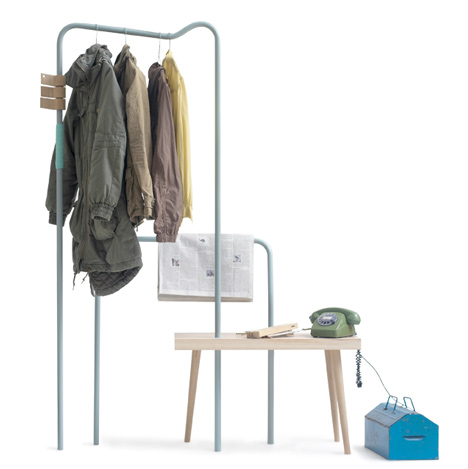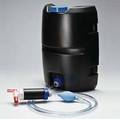Odourbuster sucks toilet odors down the pipes
by: Gizmag Emerging Technology Magazine, 2011-01-28 00:27:16 UTC

Nobody likes the smell of a just-used bathroom – and no, we don’t mean a bathroom in which someone has just bathed. That’s one of the reasons bathrooms have ceiling extractor fans, although installing the wiring and ducting for such hardware is a hassle that it would be nice to avoid, if possible. The Odourbuster is an invention that reportedly does away with the need for a fan, by taking those nasty odors and sending them where everything else went – down the toilet...
Continue Reading
Odourbuster sucks toilet odors down the pipesTags: Bathroom,
Odor,
Sewage,
Toilet,
Waste
Related Articles:


 100 Percent Renewable Energy Possible by 2030
100 Percent Renewable Energy Possible by 2030
by: Eco Geek Latest, 2011-01-25 16:03:53 UTC

A new study published in the journal Energy Policy says that we could achieve 100 percent renewable energy by 2030, and not just U.S., but the world. The study says that we have access to all the necessary technology, but strong political would have to exist for it to happen.
So, how can we get to 100 percent renewables by 2030? Well, to be exact, the study says we'll need:
- four million 5 MW wind turbines,
- 1.7 billion 3 kW roof-mounted solar PV systems,
- 90,000 300 MW solar power plants (including PV and concentrated solar), and
- a smattering of geothermal, wave and tidal power plants.
The calculations leave out biomass because of pollution and land use issues, as well as nuclear power. The wind turbines are larger than most currently operating today, but a few 5 MW offshore turbines have been built.
Two major hurdles to this plan are finding ways to interconnect the various power sources based on output and variability (wind being high output but high variability, tidal and geothermal being low output but low variability), and a supply bottleneck of rare earth materials. For those materials, mining would have to increase by five times the current rate and recycling would have to be introduced.
The authors say political roadblocks to such a massive build-up of renewable energy would be the largest challenge of all.
via Physorg
Wind Power Cost Competitive with Natural Gas
by: Eco Geek Latest, 2011-01-25 20:47:21 UTC

Wind power is reaching the point of being cost-competitive with natural gas for electrical power generation. And with more demand uncertainty for natural gas, and increasing availability and reliability of wind power, utilities are turning more to the use of wind. "Wind’s costs have dropped over the past two years, with power purchase agreements being signed in the range of 5 to 6 cents per kilowatt-hour recently."
Gas is pretty clean for a fossil fuel. But when it is burned, it is still a carbon that was otherwise locked up for long-term storage that has now been transformed into additional CO2 that has been dumped into the atmosphere. Unfortunately, gas is a more expensive option than coal, so shifting from gas to wind doesn't do as much good as it would if it was helping to displace more coal burning power.
It will be beneficial if wind power and other renewables can push the dirtier, more polluting, and environmentally harmful fuels further off the table, but long-range government policy (or the lack thereof) continues to make that difficult. The AWEA has their view: "Now that we’re competing with natural gas on cost, we need consistent federal policies to ensure we have a diverse portfolio of energy sources in this country, and don’t become over-reliant on one source or another."
via: AWEA press release
image: CC BY-SA 2.0 by Mason Bryant/Wikimedia Commons
Beaugars by Meike Langer
by: Dezeen, 2011-01-27 13:47:56 UTC

Cologne 2011: product designer Meike Langer presented this table combined with two clothes rails as part of [D3] Design Talents at imm cologne last week. (more…)


 Waste-to-Energy Plant by BIG
Waste-to-Energy Plant by BIG
by: Dezeen, 2011-01-27 14:27:15 UTC

Danish architects Bjarke Ingels Group have won a competition to design a power plant for Copenhagen with their design that will blow smoke rings and double up as a ski slope. (more…)


 One Tonne Life: Interview with Project Architect Gert Wingårdh on His Energy Efficient Building (Video)
One Tonne Life: Interview with Project Architect Gert Wingårdh on His Energy Efficient Building (Video)
by: TreeHugger Design, 2011-01-27 10:15:00 UTC
 Image via One Tonne Life - Portrait of Gert Wingårdh
Image via One Tonne Life - Portrait of Gert Wingårdh
Last week the
One Tonne Life project began in
Stockholm and TreeHugger was there to meet the key players in this fascinating low carbon lifestyle experiment. To recap, the Lindell family have moved into a solar powered
prefab house, designed b...
Read the full story on TreeHugger
What's next in eco-friendly indoor air purification systems
by: Ecofriend, 2011-01-25 04:33:23 UTC

As we know it
The Environmental Protection Agency (EPA) reported that toxic chemicals found in the air of almost every American home are three times more likely to cause some type of cancer than outdoor air pollutants. Indoor air pollutants like carbon monoxide, nitrogen oxides, sulfur oxides, hydrocarbons and particulate matter (both solid and liquid) provide risks to human health. Ironing out this risk requires proper ventilation and eliminating the source of these pollutants. But this might not always be achievable due to the climatic conditions or contaminated outdoor-atmosphere. In such conditions the artificial indoor air cleaning devices are of great help.
Need for change
With indoor air quality deteriorating due to enhanced outdoor pollution, air cleaning and purification systems are necessary and they have to be posted at strategic points in the house/office to sieve the pollutants out of the indoor atmosphere. These gadgets are also not earth-friendly, as they consume a lot of energy and some also produce harmful byproducts. Added to these are the other various issues of periodic replacement of filters, noise level and also hampering the visual appeal of the interiors. Worse still is the lack of assurance in the degree of purification accomplished by these products. The alarm is not baseless considering the harm and havoc these interior pollutants can cause to human health over time.
What’s Next?
1. GreenAir Natural Air Purifier:

What’s new:
There is strong evidence that chronic exposure to indoor air pollutants increases the risk of a range of respiratory illnesses, including acute lower respiratory infections (ALRI) in children and chronic obstructive pulmonary disease (COPD) in adults. The GreenAir Natural Air Purifier is an innovative air purifier that freshens up the environment through natural vegetation.
What difference will it make:
Designed by Sherly Gunawan, a graduate in Product Design from LASALLE College of the Arts Singapore, GreenAir Natural Air Purifier portrays the idea of growing living plants indoor to effectively and naturally clean out the indoor air of any contaminants. GreenAir employs those plants, which absorb pollutants from the air through the leaves and roots. The combination of plant roots and activated carbon has through research validated the ability to remove great amount of indoor air toxins. GreenAir has a fan inside to pull the air to the root area, using solar panels as the energy source. So, larger amount of contaminants can be purified in a shorter time. It also has self-watering system, using nylon thread as the extension of the root. So, the plants can absorb water according to its requirements. The planter is made of biodegradable material, so that when the plant has grown up it can directly be transferred to the soil and will become nutrients for the plant.
Problems:
While using these modified alternatives a detailed analysis is to be made on not only the product’s compatibility with the surroundings but also being cost-effective, safe and easy to maintain to attain the desired air purification system for the whole family.
2. Paralda Air purifier:

What’s new:
In cooler atmospheric atmospheres there is an excessive buildup of toxic particles in the air inside the house. It is these toxic irritants which actually cause colds, coughs, and allergies mostly during the winter months. Moreover the Environmental Protection Agency (EPA) reports that Americans spend almost 90 percent of the time indoors during the winter months exposing themselves to a high level of home-grown pollution from dust, tobacco smoke and other toxic particles arising from the fuel used for cooking and heating. An air purifier sometimes can keep all these allergies away.
What difference will it make:
The Paralda air purifier is completely lead-free, ozone safe, and Energy Star qualified by both the U.S. Environmental Protection Agency and the U.S. Department of Energy. The four-speed air purifier not only flaunts a stylish design but it assures the demands of the eco-minded with an impressive HEPA filtration system, UV lamp that is claimed to have a life span of over 5 years, ionizer, light touch activation controls and a 24-hour programmable timer. With all those jam-packed features the purifier still manages to keep its power consumption below 55 watts, which is way less than an old 100W light bulb. The purifier comes at a reasonable price of $499.
Problems:
While the Paralda air purifier helps improve indoor air quality it still consumes 55W of grid electricity, which can be eliminated if you install a small solar panel on the roof of your house.
3. FLO2 Air Purifier:

What’s new:
The aggravating conditions of the environment has mostly been caused by the increased pressure of population and their exploitation of technology and harmful chemicals. All these factors have degenerated the quality of the air around us. Drawing inspiration from oxygen and the process of photosynthesis, designer Olivia Bradateanu has popped up with a stylish yet functional air purifier that lets you breathe fresh, at least when you enter your living or work space.
What difference will it make:
The device lets the user know the quality of the air he or she is breathing and also purifies it by simply trapping the particles. The user-friendly device can be carried along or be placed at a favorable place in your living room. Turning the device on requires the user to slide a button, which activates the device to purify the air around it.
Problems:
Careful considerations based on the economic viability of these products are essential as each of these variants have their own advantages and disadvantages. It is very important that it not only filters the irritants in the air but they must also cost-effective, safe and non-strenuous.
4. Aura Organic:

What’s new:
Conventional air filters do help in sieving out the pollutants and enhancing the air indoors, but in the process guzzle away a large chunk of energy to keep their fans and motors running. Aura Organic air purifier however runs without electricity. The system utilizes plants that purify air of toxins like volatile organic compounds, formaldehyde, benzene and carbon monoxide.
What difference will it make:
The system utilizes plants that purify air of toxins like volatile organic compounds, formaldehyde, benzene and carbon monoxide. Designed by Ben McGinley, the Aura Organic Air Filtration system is unconventional and highly efficient, as it ensures a healthy indoor air quality healthy, without using any electrical energy.
Problems:
The Aura Organic air filtering system requires sunlight for the plants to grow for which you’ll have to keep the air purifier in the open for a few hours each day.
5. Wearable Air Purifier:

What’s new:
Not only indoors while being outdoors too the requirement for clean fresh air to breathe remains as important as ever. Wearable Air Purifier has been devised keeping this in mind. Designed with Solid Platinum Emitter Electroplated Gold Grid with stainless steel collectors, Air Supply’s Wein AS150MM Wearable Air Purifier has the most advanced plasma discharge design. It has no adapter and has been authenticated and tested by several authoritative bodies. The unit is provided with a breakaway strap for user safety and propels clean ionized air to inhale in the breathing zone. It is a very effective gadget to use in densely populated zones like the cinema halls, airplanes, waiting rooms or any other confined areas. When there is air pollution the necklace produces a sound. Thus, it warns the user to close the front of the necklace to protect himself. The body-centric wearable device, while offering clean, breathable air to the user, reuses CO2 for energy generation.
This purifier has been designed by Martina Pagura and Pedro Nakazato Andrade worked with Daviid Gauthier, Di Mainstone and Priya Mani from the Copenhagen Institute of Interaction Design. The project was developed as part of a two-week “Performative Design, Wearable Technology and Sustainability” workshop.
What difference will it make:
The Wearable Air Purifier is based on the natural process of air purification. The eco-friendly air purifier absorbs toxic gases to filter them through the leaves and roots of the plant within and puffs out fresh air.
Problems:
Before opting for any air purifier considerable speculation needs to be done on the aspects of rating them: area coverage; air changes per hour, which indicates how frequently the air purifier can exchange all the air in a given room; the clean air delivery rate, which determines how well air has been purified; energy usage; and the cost of the replacement filters.


 Samsung BE: Monitoring your energy consumption and carbon footprint to encourage green savings
Samsung BE: Monitoring your energy consumption and carbon footprint to encourage green savings
by: Ecofriend, 2011-01-25 07:02:40 UTC

Being minimalistic is the modern way to go and less is indeed more in a world where natural resources have become awfully precious. Hence, to name a gadget that monitors your consumption of these natural resources as “BE” seems pretty appropriate - simple and stylish. In a way it makes sense too, as if you are not careful enough about conservation and reducing your carbon footprint there will “be” little left for us as a race. So how does the concept creation of Tommaso Gecchelin work?

“BE” is an interactive system that will monitor your energy consumption, usage of water resources and even your carbon footprint, both in your home and when you are away. While there are many gadgets around that monitor a household’s energy consumption, BE goes a step ahead and follows you wherever you go. The Hexagonal shaped system can be attached anywhere in the home and function on solar, wind or kinetic energy.

All you need to do is sync your home with BE and it will take care of the rest. From your electrical usage to your water usage and energy wastage - BE rates everything and gives you green points which show how good or bad you have been. The “Smart Ring” that comes attached will monitor your energy consumption away from home as well and also your carbon footprint depending on the vehicle you use.

The smart interface of BE takes everything into account, including whether you are sharing your resources with someone else, in which case energy consumption/person is brought down. Then you can even share your green points through a laptop with other users of BE, which might encourage a bit of a “going green” contest.

Tommaso Gecchelin’s design hopefully will get off of the drawing board and makes it into the real world. We sure wish him and BE the very best at that!



 Non-toxic, biodegradable plastic resin promises cleaner construction materials
Non-toxic, biodegradable plastic resin promises cleaner construction materials
by: Gizmag Emerging Technology Magazine, 2011-01-26 01:31:10 UTC

Scientists from the University of Amsterdam have developed a process for making fully biodegradable, non-toxic and non-hazardous thermoset resins from readily available, low-cost plant materials. This new range of plastics could be used for panels such as MDF in the construction industry and replace polyurethane and polystyrene packaging ... all without increasing cost or production times...
Continue Reading
Non-toxic, biodegradable plastic resin promises cleaner construction materialsTags: Biodegradable,
Plastic,
Polymer,
University of Amsterdam
Related Articles:


 Ultra low-tech scale accurately weighs small items
Ultra low-tech scale accurately weighs small items
by: Gizmag Emerging Technology Magazine, 2011-01-26 21:04:57 UTC

Although we hear about amazing advances in high technology every day, it’s often the really low-tech ones that most cause us to say “Why didn’t I think of that?”. A case in point is the MP4000 Personal Post Office portable scale – a product that's been around in its current incarnation since the 70s, but that we still thought was worth a mention. Designed primarily for weighing letters in order to determine postage, the non-digital, non-electronic, and barely even mechanical little gizmo is nonetheless accurate enough that its use has been approved by the US Postal Service.
..
Continue Reading
Ultra low-tech scale accurately weighs small itemsTags: Portable,
Retro,
Shipping,
Weight
Related Articles:












Comments by our Users
Be the first to write a comment for this item.